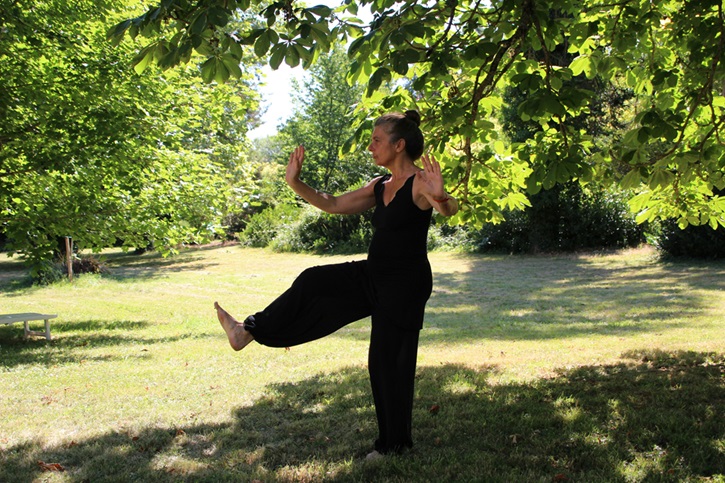Often in movies, Tai Chi is portrayed as an art form so elegant and mystical that it borders on the realm of magic. You’ll typically see a martial arts master effortlessly balance on one leg or move so gracefully that they seemingly control the wind with their movements. Yet, beyond its cinematic allure, the practice holds a wealth of untold secrets and profound health benefits waiting to be discovered.
So, what is Tai Chi exercise? Read on as this guide explores the mysteries of this practice, from its origins steeped in Chinese tradition to its various styles, intricate mechanics, and profound impact on physical and mental well-being.
What Is Tai Chi?
Tai Chi, also called Shadow Boxing, is a traditional Chinese martial art and mind-body practice characterized by slow, deliberate movements, rhythmic breathing, and mindfulness to promote physical health, mental relaxation, and spiritual well-being.
Its roots trace back to the Zhou Dynasty, where the philosophical concept of “Tai Chi” first emerged in the Book of Changes over 3000 years ago. This ancient practice embodies the essence of balance and harmony, drawing upon the principles of Taoism, which emphasize living in accord with the natural rhythms of the universe. Tai Chi epitomizes the interplay of yin and yang, the fundamental elements of existence, manifested through gentle, flowing movements and mindful awareness.
Styles of Tai Chi
Tai Chi has evolved into several distinct styles. Each one offers a different approach to practice, catering to diverse preferences and goals. Whether one seeks to improve physical fitness, cultivate mental clarity, or enhance self-defense skills, Tai Chi provides various techniques and philosophies to explore and master.
Here’s a brief overview of the main styles:
Yang Style Tai Chi
Yang Style Tai Chi features slow, graceful movements with smooth transitions between postures, making it accessible to practitioners of all ages and fitness levels. Yang Style emphasizes relaxation, balance, and internal energy cultivation.
In this form of Tai Chi movements are generally larger and more extended than other styles, promoting flexibility and joint health. Its applications focus on self-defense techniques derived from traditional martial arts principles.
Chen Style Tai Chi
Chen Style Tai Chi is characterized by slow, flowing movements and explosive bursts of energy. It incorporates low stances, vigorous movements, and complex sequences, reflecting its martial origins.
Chen Style is known for its spiral force, which generates power through twisting and coiling motions. This powerful Tai Chi style requires physical strength and endurance and is often practiced by more experienced martial artists.
Wu Style Tai Chi
Wu Style Tai Chi, developed by Wu Quanyou and his son Wu Jianquan, is notable for its compact, circular movements and subtle weight shifting. It emphasizes smooth transitions between postures and precise alignment, promoting internal relaxation and mental focus.
What makes Wu Style Tai Chi special compared to other styles are the more condensed movements, making it suitable for individuals seeking gentle, therapeutic exercise and stress relief.
Sun Style Tai Chi
Sun Style Tai Chi, developed by Sun Lutang, combines elements of Tai Chi, Xingyi, and Bagua, as well as traditional Chinese medicine principles. It features a unique blend of slow, flowing movements and agile footwork, emphasizing nimble footwork and waist rotations.
Sun Style incorporates dynamic stepping patterns and fluid transitions, promoting cardiovascular health and agility. Its gentle, relaxed movements make it particularly suitable for individuals with arthritis or joint issues.
How Tai Chi Works?

Tai Chi is a practice that aims to harmonize the flow of Qi, which is the vital energy that flows throughout the body. This promotes balance and harmony between a person’s physical, mental, and spiritual elements.
Tai Chi involves slow and deliberate movements that help cultivate awareness of internal sensations, making it easier for Qi to flow freely along the body’s energy pathways. By synchronizing breath with movement and maintaining a relaxed yet focused state of mind, practitioners can enhance emotional regulation, reduce stress, and attain inner tranquility.
Health Benefits of Tai Chi
Tai Chi offers numerous health benefits that encompass both physical and mental well-being, such as:
Improved balance and stability
Tai Chi is a potent tool for improving balance and stability by emphasizing weight shifting, controlled movements, and mindful awareness. By cultivating a heightened sense of proprioception and body awareness, practitioners learn to move with grace and fluidity, thus reducing the risk of falls and injuries.
The slow, deliberate nature of Tai Chi practice allows individuals to develop a strong foundation of stability from which they can confidently navigate their daily activities with greater ease and confidence.
Stress reduction
The meditative qualities inherent in Tai Chi make it effective for stress reduction and relaxation. Practitioners can alleviate tension, reduce anxiety, and promote emotional well-being by focusing on the present moment and cultivating mindful awareness.
Tai Chi has been shown to modulate the body’s stress response, leading to lower levels of cortisol and increased feelings of calmness and tranquility. Over time, individuals may experience improved mood, enhanced resilience to stress, as well as a greater overall sense of mental well-being.
Enhanced flexibility
The gentle, flowing motions of Tai Chi serve to promote flexibility and suppleness throughout the body. By encouraging a full range of motion in the joints and muscles, Tai Chi helps prevent stiffness, improve mobility, and maintain overall joint health.
The slow, deliberate movements allow individuals to gently stretch and release tension, promoting relaxation and ease of movement. Therefore, regular practice of Tai Chi can lead to increased flexibility, reduced risk of injury, and a greater sense of comfort and ease in everyday activities.
Cardiovascular health
Tai Chi also offers significant benefits for cardiovascular health, including improved heart health, circulation, and overall cardiovascular fitness. The gentle, rhythmic movements of Tai Chi help regulate blood pressure, reduce cholesterol levels, and enhance circulation throughout the body.
Moreover, Tai Chi provides a low-impact exercise suitable for individuals of all ages and fitness levels, making it an accessible and effective way to promote heart health and overall well-being.
Pain relief
Tai Chi is beneficial for managing and relieving chronic pain, particularly joint pain and arthritis. By promoting proper posture, alignment, and joint flexibility, Tai Chi helps reduce strain on the muscles and joints, alleviating pain and discomfort.
The gentle, flowing movements of Tai Chi release tension in the body, further reducing pain and fostering a greater sense of comfort and well-being. It can also help individuals become more aware of their bodies and develop better coping mechanisms for pain and discomfort, improving their quality of life.
Who Is Tai Chi Suitable For?

Tai Chi is suitable for individuals of all ages, fitness levels, and health conditions due to its adaptability and accessibility. For example, elderly individuals benefit from Tai Chi’s gentle, low-impact nature, which helps improve balance, flexibility, and joint health.
On the other hand, younger adults also benefit from it, as the practice offers a unique blend of relaxation and physical exercise, promoting stress reduction and overall well-being.
Individuals with chronic health conditions, such as arthritis or hypertension, can also benefit from Tai Chi as long as they consult with a healthcare professional and adapt movements to their abilities.
Tai Chi Risks
Tai Chi is generally considered a safe form of exercise. Still, exercising caution or consulting a healthcare professional before starting a practice is important, especially if you have any underlying medical conditions.
For instance, individuals with severe musculoskeletal issues, uncontrolled high blood pressure, or cardiovascular conditions may need guidance due to the exertion involved. Similarly, individuals with balance disorders or a history of falls should proceed carefully, while pregnant women and those who suffer from chronic pain or inflammatory disorders should consult their healthcare provider to ensure that movements are safe for them.
The Bottom Line
All in all, Tai Chi stands as a timeless practice that offers a wealth of benefits for both body and mind. Its gentle yet powerful movements promote balance, flexibility, and inner harmony, making it a valuable tool for improving overall well-being.
While the rewards of Tai Chi are plentiful, it’s essential to approach the practice with caution, especially if you have pre-existing health conditions. Consulting with a healthcare professional ensures that you can safely embark on this journey of self-discovery and holistic wellness. Through Tai Chi, grace meets strength, and mindfulness intertwines with movement, paving the way for a healthier, more balanced life.
FAQ
Does tai chi actually work?
Yes, numerous studies have shown that tai chi offers various health benefits, including improved balance, flexibility, cardiovascular health, and stress reduction.
What happens if you do tai chi everyday?
Regular practice of tai chi can lead to increased physical fitness, mental clarity, emotional well-being, and overall quality of life. It can also help reduce the risk of falls, manage chronic pain, and promote relaxation.
Why is tai chi so difficult?
Tai chi can be challenging due to its focus on precise body mechanics, coordination, and balance. However, with patience, practice, and mindfulness, mastering the fluid, controlled movements is achievable. Consistent effort and dedication can lead to significant improvements in technique and overall proficiency in tai chi practice.